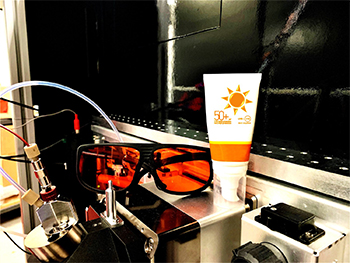Is your sunscreen as good as it could be?
Posted on 7 May 2019

Following research into the organic compound oxybenzone, once widely used in sunscreen lotion, scientists argue that products should carry a standardised measure of when the chemicals start to breakdown, offering less sun protection to the user as it did in the initial hours of application.
The effect of individual ingredients in bulk sunscreen formulations has previously been a challenge to study, seeing as they exist alongside a number of other UV-absorbing components in solution.
Scientists at the University of York have now developed a novel method of isolating sunscreen molecules, like oxybenzone, in the gas phase and can test the ability of these sunscreens to absorb UV light after exposure to UV photons from a laser.
They found evidence that certain forms of oxybenzone display a tendency to break down when they interact with light, limiting its ability to protect against UV rays.
Dr Caroline Dessent, from the University of York’s Department of Chemistry, said: “Oxybenzone is known to absorb UV rays and was once very widely used in sunscreen mixtures, until concerns were raised about its ability to penetrate the skin.
“Although it can be found in limited supply in some products, manufacturers now tend to use other compounds that carry less risk.
“It is, however, a valuable sunscreen chemical to use as a model for how other, more regularly-used, sunscreen compounds might react to UV rays, and is a good place to start when trying to develop new methods for testing how durable these types of chemicals are.”
As our skin is constantly being exposed to varying pH levels, with sweat being mildly acidic and chlorinated swimming pools being alkaline, the team at York have carried out their experiments on oxybenzone in both its acidic and alkaline forms.
Using a UV laser coupled to a mass spectrometer, which produces these chemical substances in their acidic and alkaline forms, the team were able to measure how strongly these forms of oxybenzone, in its gaseous state, absorb light from the laser.
The team reported that shining light on the alkaline form of the sunscreen oxybenzone produces free radicals, which are widely known to damage the skin’s DNA and cause ageing of the skin.
Natalie Wong, PhD student in the Department of Chemistry at the University of York, said: “If you are going to be in the sun for a number of hours, you would obviously want your sunscreen to maintain its high performance for a long time. You would ideally need these sunscreens to absorb the harmful UV rays and, in turn, release the energy as heat.
“Currently there is no commercial standard for stating that sunscreen will protect you over extended periods of time.”
The work being conducted at the University of York provides a basis for developing more rigorous testing regimes, and will now be used to investigate more commonly-used sunscreen chemicals so that manufacturers and consumers can be more informed about the best sunscreen products for protecting themselves for as long as they are in the sun.
Dr Jacob Berenbeim, from the University of York’s Department of Chemistry, said: “It is still imperative to use sunscreen. Here, we are investigating nuanced photochemical effects to better tailor future products and educate the public.
“The reduced rates of skin cancer as a result of methods of sun protection has shown that these products are needed, but research could offer even better protection now that we have improved methods of understanding the stability of their chemicals.”
In the future, researchers would like to see bottles labelled with a meaningful measure of the breakdown rate of these chemicals, so that consumers know when to re-apply the product for lasting skin protection.
The research is published in the journal Physical Chemistry Chemical Physics (PCCP).
